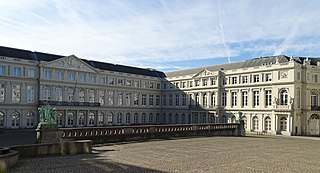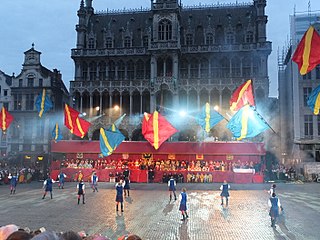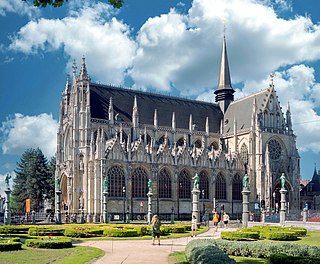
The City of Brussels is the largest municipality and historical centre of the Brussels-Capital Region, as well as the capital of the Flemish Region and Belgium. The City of Brussels is also the administrative centre of the European Union, as it hosts a number of principal EU institutions in its European Quarter.

The Palace of Justice of Brussels or Law Courts of Brussels is a courthouse in Brussels, Belgium. It is the country's most important court building, seat of the judicial arrondissement of Brussels, as well as of several courts and tribunals, including the Court of Cassation, the Court of Assizes, the Court of Appeal of Brussels, the Tribunal of First Instance of Brussels, and the Bar Association of Brussels.

The Egmont Palace, also sometimes known as the Arenberg Palace, is a neoclassical palace in Brussels, Belgium. It was originally built between 1548 and 1560 for Countess Françoise of Luxembourg and Count Lamoral of Egmont, though its appearance was heavily modified in the 18th and 19th centuries. It was partly destroyed by fire in 1892, after which it was once again reconstructed. Nowadays, it is used by the Belgian Ministry of Foreign Affairs for receptions, as a guest house and conference centre.

The Mont des Arts or Kunstberg, meaning "Hill/Mount of the Arts", is an urban complex and historic site in central Brussels, Belgium, including the Royal Library of Belgium (KBR), the National Archives of Belgium, the Square – Brussels Meeting Centre, and a public garden.

The Union Libérale Israélite de France, commonly referred to as the rue Copernic synagogue, is a Reform Jewish congregation and synagogue, located in the XVIe arrondissement of Paris, France. Inaugurated on 1 December 1907, it is the oldest Reform synagogue in France.

The Palace of Charles of Lorraine is a neoclassical palace in the Royal Quarter of Brussels, Belgium. Its construction started in 1757 to serve as the residence of the Governor of the Habsburg Netherlands, Prince Charles Alexander of Lorraine, replacing the Palace of Orange-Nassau. It currently houses a museum, part of the Royal Library of Belgium (KBR).
The Union des progressistes juifs de Belgique is a Belgian Jewish organization set up in 1939 as Solidarité juive by antifascist Jews in Belgium, becoming in 1946 Solidarité juive, aide aux victimes de l'oppresseur nazi. It took on its present name in 1969.

The Maison du Peuple (French) or Volkshuis (Dutch), both literally the "House of the People", was a public building located on the Place Emile Vandervelde/Emile Vanderveldeplein, in the Sablon/Zavel district of Brussels, Belgium. It was one of the most influential Art Nouveau buildings in Belgium and one of the most notable designs by the architect Victor Horta. Commissioned by the Belgian Workers' Party (POB/BWP), it was constructed between 1896 and 1899, and opened on 2 April 1899.

The Rue Royale or Koningsstraat is a street in Brussels, Belgium, running through the municipalities of Schaerbeek, Saint-Josse-ten-Noode and the City of Brussels. It is limited to the south by the Place Royale/Koningsplein in the city centre and to the north by the Place de la Reine/Koninginplein in Schaerbeek.

The Temple of the Augustinians, alternatively the Church of the Augustinians in Brussels, Belgium, was a Brabantine Baroque-style church designed and built from 1621 to 1642 by the architect Jacob Franquart for the Augustinians order. It was located on the Place de Brouckère/De Brouckèreplein in central Brussels until its demolition in 1893–94. Its façade's masonry, however, was preserved, being disassembled and reconstructed as the façade of the Church of the Holy Trinity in Ixelles.

The Ommegang of Brussels is a traditional Ommegang, a type of medieval pageant, celebrated annually in Brussels, Belgium.

The Grand Synagogue of Paris, generally known as Synagogue de la Victoire or Grande Synagogue de la Victoire, is an Orthodox Jewish congregation and synagogue, located at 44, Rue de la Victoire, in the IXe arrondissement of Paris, France.

The Brussels massacre was an anti-Semitic episode in Brussels in 1370 in connection with an alleged host desecration at the Brussels synagogue. A number of Jews, variously given as six or about twenty, were executed or otherwise killed, while the rest of the small community was banished. The event occurred on May 22.

The Church of Our Lady of Victories at the Sablon, or the Church of Our Lady of the Sablon, is a Catholic church located in the Sablon/Zavel district, in the historic centre of Brussels, Belgium. It is dedicated to Our Lady of the Sablon.

The Sablon or Zavel is a neighbourhood and hill in the historic upper town of Brussels, Belgium. At its heart are twin squares: the larger Grand Sablon or Grote Zavel square in the north-west and the smaller Petit Sablon or Kleine Zavel square and garden in the south-east, divided by the Church of Our Blessed Lady of the Sablon. This area is served by Brussels-Chapel railway station and Brussels-Central railway station, as well as the tram stop Petit Sablon/Kleine Zavel.

The Jewish Museum of Belgium is a museum in central Brussels, Belgium, focusing on the history of the Jews in Belgium. It is located at 21, rue des Minimes/Minimenstraat in the Sablon/Zavel district of Brussels. This site is served by the bus stop Grand Sablon/Grote Zavel.

The Palace of the Count of Flanders is a neoclassical palace in Brussels, Belgium. It was originally built between 1776 and 1781 for Countess Brigitte of Tirimont-Templeuve, though it was heavily expanded in the 19th century. Nowadays, it houses the Court of Audit of Belgium.

Maxime Steinberg (1936–2010) was a Belgian historian and teacher who wrote extensively on the Holocaust in Belgium. He has been described as "Belgium's principal Holocaust historian" and was best known for his three-part history of the subject entitled L'Étoile et le Fusil, published in 1983–87.
The Israelite Seminary of France also known as the Central Rabbinical School of France , is a Rabbinical school that trains Orthodox rabbis in France. Founded in Metz in 1829 as the Central Rabbinical School of Metz, it moved to Paris in 1859, where it is based in the city's 5th arrondissement. The school is connected with the Israelite Central Consistory of France, one of the major bodies of Orthodox Judaism in France.

The Synagogue of Anderlecht, officially the Synagogue of the Orthodox Jewish Community of Brussels, and also known as the Israelite Orthodox Synagogue of Cureghem, is an Orthodox Jewish synagogue, located in the heart of the former Jewish quarter of Cureghem/Kuregem, at 67A, rue de la Clinique/Kliniekstraat, in the municipality of Anderlecht, Brussels, Belgium. The synagogue is the main synagogue of the Israelite Orthodox Community of Brussels. It can be accessed from Clemenceau metro station on lines 2 and 6 of the Brussels Metro.



















